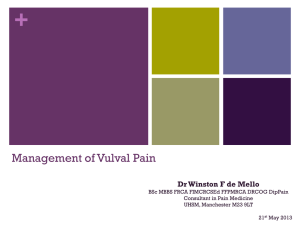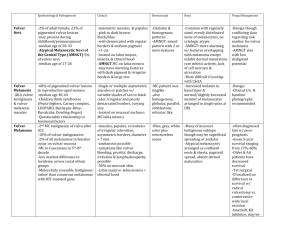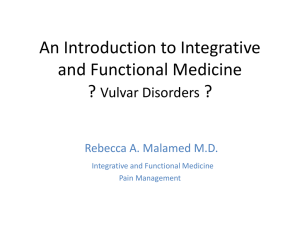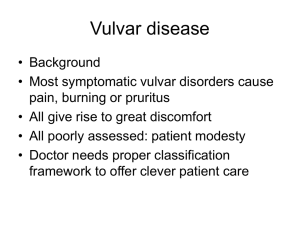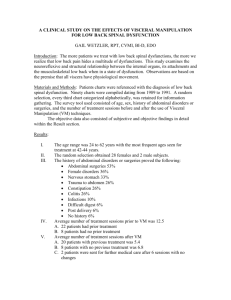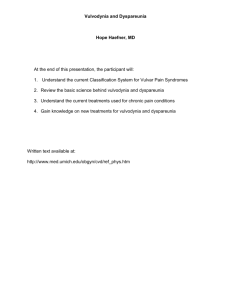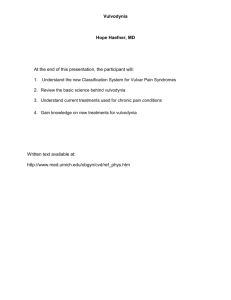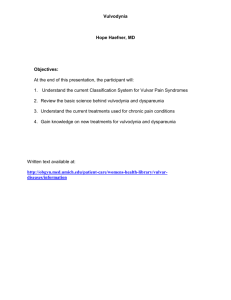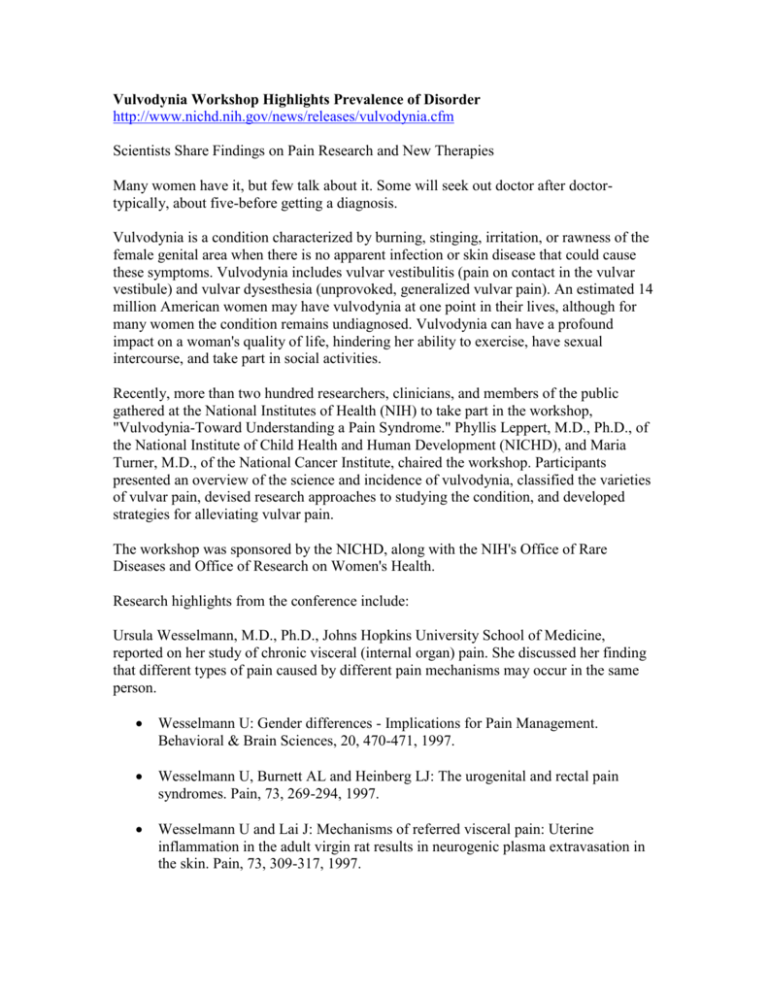
Vulvodynia Workshop Highlights Prevalence of Disorder
http://www.nichd.nih.gov/news/releases/vulvodynia.cfm
Scientists Share Findings on Pain Research and New Therapies
Many women have it, but few talk about it. Some will seek out doctor after doctortypically, about five-before getting a diagnosis.
Vulvodynia is a condition characterized by burning, stinging, irritation, or rawness of the
female genital area when there is no apparent infection or skin disease that could cause
these symptoms. Vulvodynia includes vulvar vestibulitis (pain on contact in the vulvar
vestibule) and vulvar dysesthesia (unprovoked, generalized vulvar pain). An estimated 14
million American women may have vulvodynia at one point in their lives, although for
many women the condition remains undiagnosed. Vulvodynia can have a profound
impact on a woman's quality of life, hindering her ability to exercise, have sexual
intercourse, and take part in social activities.
Recently, more than two hundred researchers, clinicians, and members of the public
gathered at the National Institutes of Health (NIH) to take part in the workshop,
"Vulvodynia-Toward Understanding a Pain Syndrome." Phyllis Leppert, M.D., Ph.D., of
the National Institute of Child Health and Human Development (NICHD), and Maria
Turner, M.D., of the National Cancer Institute, chaired the workshop. Participants
presented an overview of the science and incidence of vulvodynia, classified the varieties
of vulvar pain, devised research approaches to studying the condition, and developed
strategies for alleviating vulvar pain.
The workshop was sponsored by the NICHD, along with the NIH's Office of Rare
Diseases and Office of Research on Women's Health.
Research highlights from the conference include:
Ursula Wesselmann, M.D., Ph.D., Johns Hopkins University School of Medicine,
reported on her study of chronic visceral (internal organ) pain. She discussed her finding
that different types of pain caused by different pain mechanisms may occur in the same
person.
Wesselmann U: Gender differences - Implications for Pain Management.
Behavioral & Brain Sciences, 20, 470-471, 1997.
Wesselmann U, Burnett AL and Heinberg LJ: The urogenital and rectal pain
syndromes. Pain, 73, 269-294, 1997.
Wesselmann U and Lai J: Mechanisms of referred visceral pain: Uterine
inflammation in the adult virgin rat results in neurogenic plasma extravasation in
the skin. Pain, 73, 309-317, 1997.
Wesselmann U, Czakanski PP, Affaitati B. and Giamberardino MA: Uterine
inflammation as a noxious visceral stimulus: behavioral characterization in the
rat. Neurosci. Lett., 246, 73-76, 1998.
Wesselmann U: Management of Chronic Pelvic Pain. Pages 269-279 in G. M.
ARONOFF, Ed., Evaluation and Treatment of Chronic Pain. 3rd edition,
Williams and Wilkins, Baltimore, MD, 1998.
Burnett A L and Wesselmann U: Neurobiology of the pelvis and perineum:
Principles for a practical approach. J. Pelvic Surgery, 5, 224-232, 1999.
Wesselmann U: A call for recognizing, legitimizing and treating chronic visceral
pain syndromes. Pain Forum, 8, 146-150, 1999
Wesselmann U: Guest Editorial: Pain - the neglected aspect of visceral disease.
Eur. J. Pain, 3, 189-191, 1999
Wesselmann U and Burnett AL: Genitourinary Pain. Pages 689-709 in P.D.
WALL, and R. MELZACK, Eds., Textbook of Pain. 4th edition, Churchill
Livingstone, New York, NY, 1999.
Wesselmann U: Pain of pelvic origin. In: Pain 1999 - An Updated Review:
Refresher Course Syllabus - International Association for the Study of Pain,
Editor: M. Max, IASP Press, Seattle, pages 47-58, 1999
Wesselmann U and Czakanski PP: Pain of urogenital origin. Curr. Rev. Pain, 3,
160-171, 1999
Wesselmann U, Czakanski PP, and Sanders C: Altered CNS processing of
nociceptive messages from the vagina in rats, that have recovered from uterine
inflammation. Progress in Pain Research and Management, 16, 581-588, 2000.
Wesselmann U: Urogenital pain syndromes in men and women. Progress in Pain
Research and Management, 16, 551-566, 2000.

